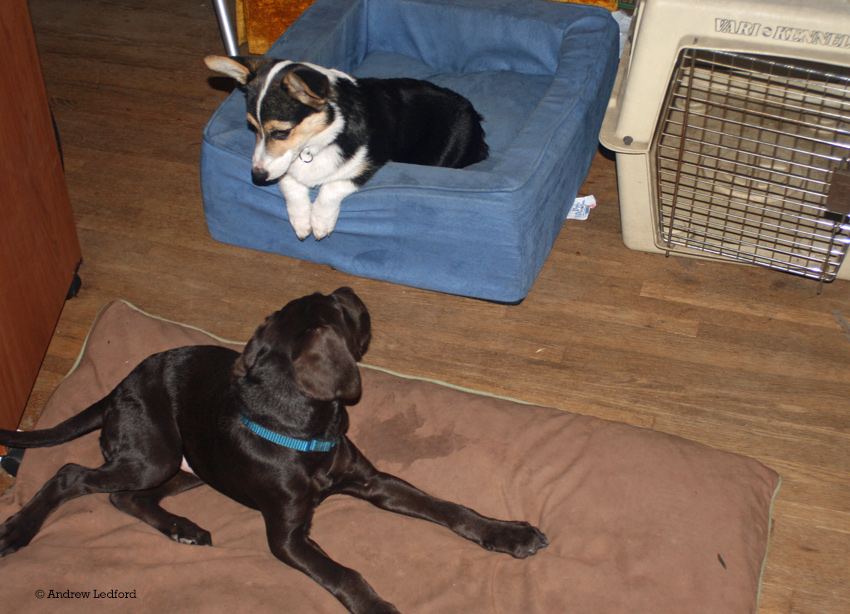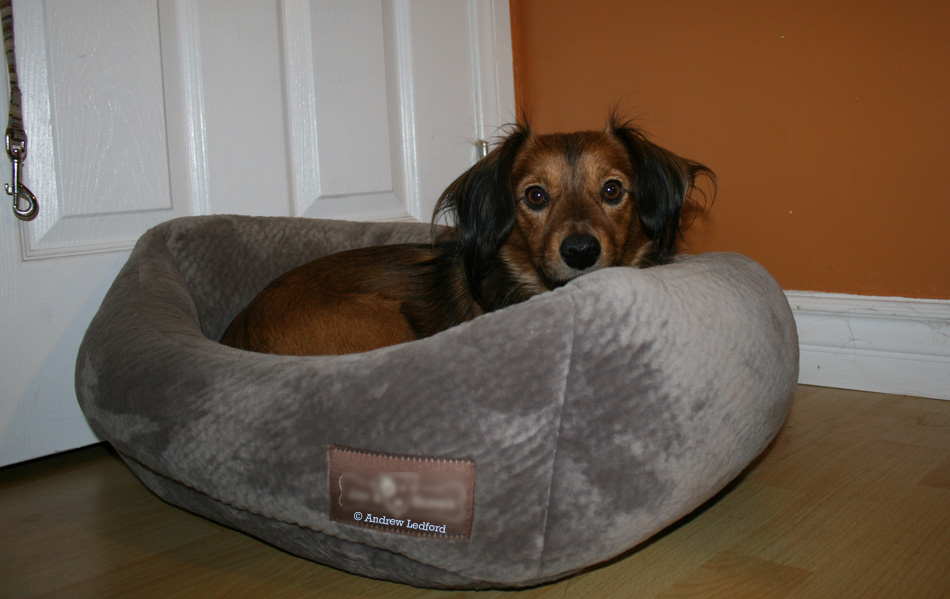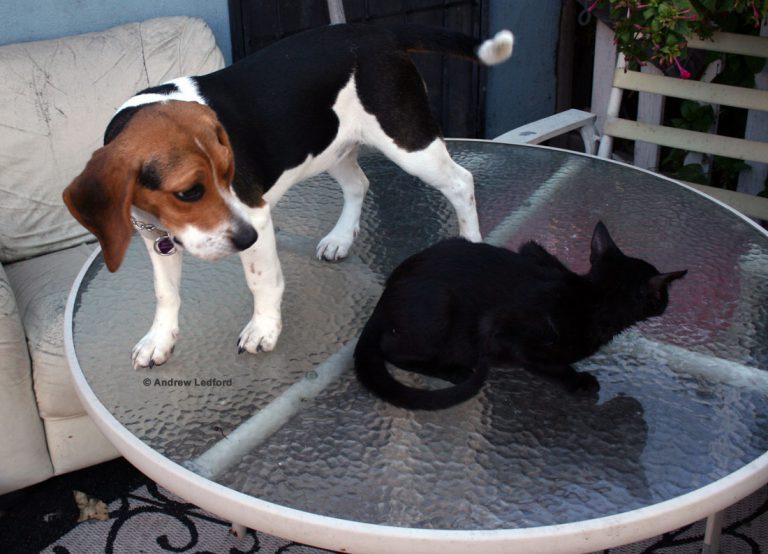How to train your dog for the home office and the working from home lifestyle
Dog training for the home office
With more people working from home there’s an increasing need for dogs to learn good home office manners. Over the last year I’ve been on a lot of video conference calls with misbehaving and distracting pets in the background. Video calls really became popular starting in the early days of the stay at home Covid-19 orders. As we adjust to living with Covid, the online video calls continue and our pets continue to make themselves known. Sometimes in cute ways and other times they are distracting.
I’ve noticed quite often our animals interrupt online meetings. For informal meetings and chats it’s not much of a problem, but for important business, it can be. I have to say it’s a little annoying to have an unmuted person with a barking dog in the background hogging the talk box on a zoom call.
Not only does it interrupt the meeting, but more importantly, the thought process of all the meeting participants. Whether the meeting is for learning or problem solving, the disruption can have an impact on the business outcome. An untrained dog can cut the productivity of an entire work team.
That is where I can help. Let’s look at some steps we can take to tame the canine interruptions.
We can classify office manners as a subset of house manners. Once a dog has mastered the skills needed for good house manners, being in the office should be easy.
Even with the best behaved dogs, when in high profile meetings, you still need to use sound judgement while practicing good animal management and handling. If you know you’ll be on an extremely important phone/video call, put the dog somewhere it won’t interrupt the meeting. A well designed dog friendly home will have an area that can be used as a dog/crate room. Even well behaved and highly trained dogs can be disruptive.
Just about everyone who works from a home office should crate train their dogs. A crate trained dog is one that’s comfortable in the crate, will go into its crate willingly, and stay in the crate quietly for extended periods of time. When crate training, don’t use the crate for punishment. It can be used as a place for time out, but this needs to be done in a very neutral manner.
Even well trained dogs can interrupt our train of thought by performing one of their learned behaviors at an inopportune time. This is not uncommon when the dog’s people are showing signs of stress, such as being in an extremely important meeting. Even if you sound totally in control to the other party, your dog knows better and may respond accordingly.
Don’t reward undesirable office behavior. Many people unknowingly reward their dogs for misbehavior. Often I will be telling someone not to pet, talk to or look at a dog when it misbehaves and while I am talking with them the dog performs the undesirable behavior and they immediately pet the dog. Which does provide a teaching moment and gives a good in the moment example of exactly what I was telling them not to do.
Whenever you look at, talk to, or touch, the dog, you are probably rewarding it. But we also use these same behaviors to correct the dog. Know what you are doing and why you are doing it. Then monitor what kind of results you are getting.
If you’re acting different than what the dog is used to, it may act different too.
There are a few types of responses we can expect from dogs when we’re preoccupied in a home office meeting.
Many dogs will react to your unusual behavior by becoming more active.
Talking to the spirits is something people and dogs notice. Imagine that you enter a room and someone is talking to their desk or the wall with all the body language, nuances, and intonation of interpersonal communication. At first most people and many dogs think that is unusual behavior. Before cell phones only mentally challenged individuals used to talk to themselves like they were talking to another person. Now everyone does it. But it can be a little confusing for some dogs. Just being confused is another reason some dogs have a harder time in the office. Is mom or dad talking to me, the dog, to the wall, to the desk, or to someone outside the room? What are those humans doing?
If your dog is trained to an extremely high level you may accidentally tell it to do something you don’t want it to do while in a high profile meeting. One day I was watching a video of me doing some dog training and out of the corner of my eye I noticed my dog acting a bit unusual. Then I realized he was sitting and laying down when I was telling the dog in the video to sit and lay down.
Now that I have mentioned how we can accidentally give commands we don’t intend to give, I need to clarify that dogs are very good at knowing when we are talking to them, someone else, or something else. Each dog is an individual and responds differently. This is why it is important to know your dog and its peculiarities.
I will segment several kinds of home office dog behavior problems into a few categories.
- Destress
- Threat / Defensive
- Fun time
- Play solicitation
Distress is an overall level of discomfort from stress that leads to displacement behavior and increased activity. Distress Can lead to a general state of heightened anxiety. Along with higher levels of activity we often see vocalizations with displacement behavior. Some common displacement behaviors seen are grooming, soliciting social interaction, paw raising that can lead to pawing, dropping a toy in your lap or on the floor, and the list goes on. Teaching your dog to chew a specific toy on the dog’s bed is a good way to redirect displacement behavior into something more desirable.
Threat / Defensive problems are where the dog picks up on your discomfort and treats it as though there is an unknown threat. Again we see heightened levels of activity, sometimes accompanied with vocalization and/or defensive care seeking behavior. One of the defensive care seeking behaviors that may be noticed is leaning or pushing against the owner.
The UPS truck and mailperson.
A lot of dogs bark quite ferociously at either and often both the UPS truck and mailman. If this is your dog, you will need to do some focused training to overcome the behavior. Getting a very reliable recall is the first step to controlling this type of defensive behavior. While working on the recall may fix the excessive barking there’s a very good chance you’ll need to do more training. It might be necessary to enroll the dog into a formal dog training program.
Fun time occurs in the home office when pet parents are chained or tied to their desk/computer. It’s a case of mom or dad is tied up, let’s have fun. Generally, problems during fun time can be cured with the proper training. The big problem with a lot of dogs is that they learn to misbehave more because of how they are handled during these episodes of having short periods of free rein. Once the inappropriate behavior is well conditioned it takes more effort to train for good home office manners. A simple solution that often works for this problem is to keep the dog on a leash.
Keeping training treats on the desk or within easy reach is a very good plan. With treats ready you can reward good behavior as well as shape desirable behavior. While on the phone look for opportunities to reward the behavior you want.
Dog training for the home office.
For good home office manners train your dog to stay on its bed. One of the first behaviors I teach dogs who are living with me is to stay on a dog bed. This is especially important when they’re in my office. It’s also quite helpful to train the dog to go to the bed on a hand signal. You can then direct a mischievous dog to a safe place without saying a thing. It’s also good to learn how to use the mute button when on a video conference call. You can find tech tips at MyOnTheRoad.Net site.

As mentioned before some dogs get a little stressed when their people are on a call. You may need to train for call and meeting manners. The time to practice good home office manners is on low stakes nonbusiness calls. Call a friend or relative and chat as a training exercise.
It’s not uncommon for me to put someone on hold or need to call them back because a dog is misbehaving. I need to stop the call so I can teach the dog it needs to behave even if it thinks I am preoccupied or acting weird. It’s best if you plan and train for meetings in advance, instead of trying to train the dog during a business meeting. Train the behavior you need before you really need it.
As mentioned earlier when possible I like to teach dogs to chew a specific toy. Some dogs don’t like chewing toys. That’s okay, don’t force it and find another exercise. For dogs that like to chew you may want to give it a special toy when the dog is on its office bed. If a dog likes hard nylon bones I may give a slightly softer Fido Extra-Tuff Dental Bone when in the office. By the way many dogs that don’t like hard nylon bones really like the Fido Extra-Tuff Bones.
Another good type of toy to use is a food filled toy that does not roll or bounce too much. You can find hard rubber toys that can be filled with food such as biscuits or peanut butter. When using peanut butter make sure the peanut butter does not have a dog toxic sweetener in it, such as Xylitol.
I recommend teaching the dog to get its toy on a hand signal. You will also have better control if you put the come “Here” command on a hand signal so you can call the dog to you and then send it to get its toy with another hand signal. If “Bed” is also on a hand signal you can then send your dog to its bed as well.
If your dog knows these commands you’ll have fairly good control. You can call the dog to you, have it get its toy, and send the dog away from you to its bed. With these hand signals you will have command control of your dog all without saying a word. While you will not verbally interrupt the online meeting, it will take your focus off the call for a short period of time.
Here is a dog training/handling secret – keep the dog on a leash until you know its good behavior is reliable. If your dog is on a leash you will not have to chase the dog down if it decides to take a precious object or chew on an essential piece of equipment. I have seen quite a few dogs that like chewing the power cable used for charging MacBooks.
Doggy Pushups.
Another dog exercise that can be done while the dog is on its bed are doggy pushups. These are taught using a food lure and reward. First you lure the dog into a “sit” position and then into a “Down” then back into a “Sit.” You are doing many repetitions of “Sit” and Down.” Try to end the sequence by calling the dog and sending it back to its bed then finish with a down. it’s okay to give the verbal command in the beginning stages of the training. But put it on a hand signal so it can be used most effectively in a home office meeting scenario.
Outside Barking.
Barking while outside can be more difficult to control and is influenced by multiple variables. Some things will be out of your control and others you can more or less influence. Yard design and features can influence many behaviors. Barking is one of these. A well designed yard will decrease the opportunities for barking and make it easier to control. Eliminating trees and plants that attract wildlife is one element of designing for a quieter backyard. The size of the yard, fencing, and landscaping can also contribute to controlling undesirable barking. A dog friendly yard design is something to consider when purchasing a dog friendly home.
I would also suggest getting at least double pane windows made to block noise for the home office. But there are more sophisticated solutions such as acoustic window panels. These may be necessary if it’s not your dog, but the neighbor’s dog who is making your home office workspace less than ideal.
Here is a training list that will increase good home office dog behavior.
- For good home office manners train your dog to stay on its bed
- To go to bed on a hand signal
- Be good while on a call
- To be quiet – Give a special toy when on calls
- To get toy on command
- Dog pushups
- Put the dog on a leash
- Don’t reward attention-seeking behavior – vocalization, Begging, or Whining
- Start with a routine and then train away form the routine – break it
- Crate training
- Designated dog area
- Go outside and play
Wishing you the very best in dog training and I life,
Andrew Ledford
I can be reached at 714-827-4058



